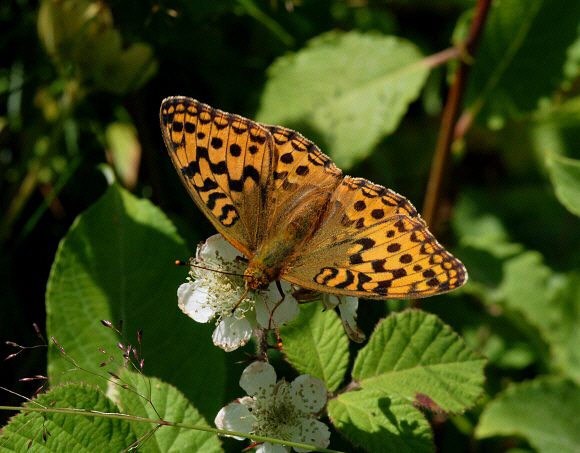 Argynnis adippe, female nectaring at bramble, Arnside Knott, Cumbria – Adrian Hoskins
Argynnis adippe, female nectaring at bramble, Arnside Knott, Cumbria – Adrian Hoskins
Introduction
The genus Argynnis comprises of about 25 species, found variously in Europe, temperate Asia and North America. Certain workers include an additional 18 Speyeria species within Argynnis.
The High Brown Fritillary Argynnis adippe is distributed across much of Europe, but is absent from northern Scandinavia, and the Mediterranean islands ( except Sicily ).
It can easily be mistaken for the Dark Green Fritillary, which often shares its habitats, but the male of aglaia lacks the conspicuous black sex brands which run along veins 2 and 3 of the forewing of adippe. The ground colour of female High Brown Fritillaries is golden, whereas in females of aglaia it is more reddish brown with noticeably pale outer margins. In both sexes the outer edge of the fore-wings is almost straight in aglaia, but is slightly concave in adippe. The size and positioning of the black spots is variable in both species. On the undersides the differences are more pronounced – the High Brown Fritillary has a yellowish ground colour with no trace of green, and has an additional row of white-centred reddish spots in the submarginal area of the hindwings.
In continental Europe this species can be confused with the Niobe Fritillary Argynnis niobe, but the latter is smaller and has more chevron-like lunules on the underside.
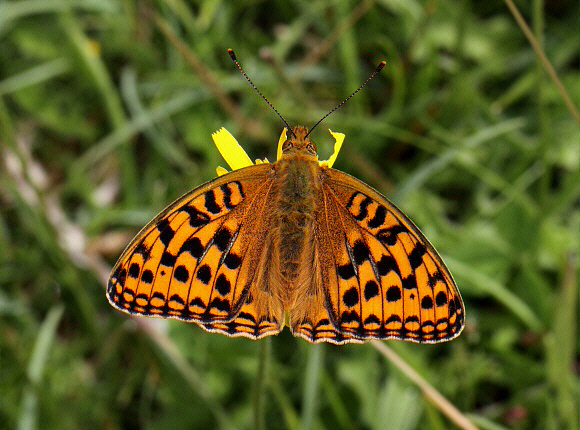 Argynnis adippe male, Arnside Knott, Cumbria – Adrian Hoskins
Argynnis adippe male, Arnside Knott, Cumbria – Adrian Hoskins
Habitats
The High Brown Fritillary was formerly very widespread in Britain, and occurred commonly in most of the larger woodlands in southern England and Wales, although it became scarcer in the northern counties. During the mid 20th century the butterfly declined very rapidly as a result of habitat loss. The coppiced woodlands where it once bred became neglected and overgrown, or were converted to plantations of oak, beech or conifers. Consequently the larval foodplants were shaded out and the species was lost.
This is one of the most rapidly declining species in Britain. It has proven incapable of surviving at the small number of isolated sites which are still actively coppiced. The butterfly’s long term viability depends on the existence of extensive tracts of well drained and lightly wooded habitat where the larval foodplant, dog violet Viola riviniana grows profusely and in continual supply. These habitats are now very scarce, so most of the woodland colonies have long disappeared, and the butterfly is now largely restricted to a few small and isolated areas of scrubby grassland / woodland mosaics on limestone hills, where periodic cattle grazing, bracken control, and retention of scrub are vital elements in ensuring it’s continued survival.
In Europe it is much more catholic in it’s choice of habitats, occuring on scrubby grassland, sparsely vegetated limestone plateaux, and in sub-alpine meadows and woodland / grassland mosaics. It’s choice of larval foodplants is also wider and includes Viola hirta, V. riviniana and V. odorata.
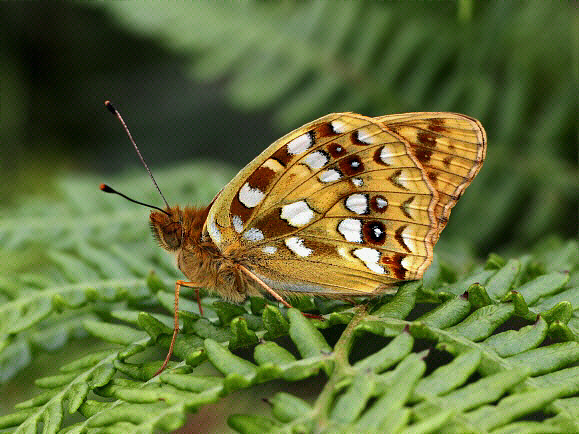 Argynnis adippe male, Arnside Knott, Cumbria – Adrian Hoskins
Argynnis adippe male, Arnside Knott, Cumbria – Adrian Hoskins
As well as the normal form, adippe produces a variety cleodoxa in which the silvery spots on the underside are replaced with yellow.
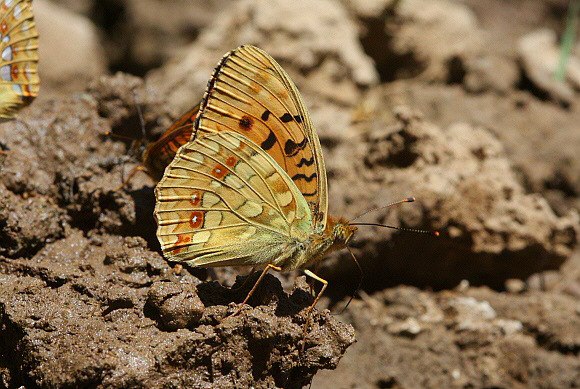 Argynnis adippe, male form cleodoxa, Aggtelek, Hungary – Peter Bruce-Jones
Argynnis adippe, male form cleodoxa, Aggtelek, Hungary – Peter Bruce-Jones
Lifecycle
The butterflies emerge in late June and early July. They lay their pinkish conical eggs singly on dead bracken fronds, dead leaves, dry stems or bits of moss, very close to the larval foodplants. They are normally deposited in sheltered nooks, in the dappled sunlight beneath bracken, gorse or straggling patches of low bramble growth. The tiny caterpillars quickly develop within the eggs, but don’t hatch until March of the following year.
The fully grown larva is dark brown, with a white stripe along the back, and is covered with rows of brown or pinkish spikes along the back and sides. It lives solitarily, wandering from one violet plant to another, and feeds diurnally, periodically retiring to rest beneath dead leaves.
The dark brown, shiny chrysalis resembles a withered leaf, and is virtually impossible to locate in the wild. In captivity it is formed attached by the cremaster to a silk pad spun on twigs or stems, and in the wild it is probably suspended from twigs or woody stems beneath bushes. The pupal stage lasts for about 3 weeks.
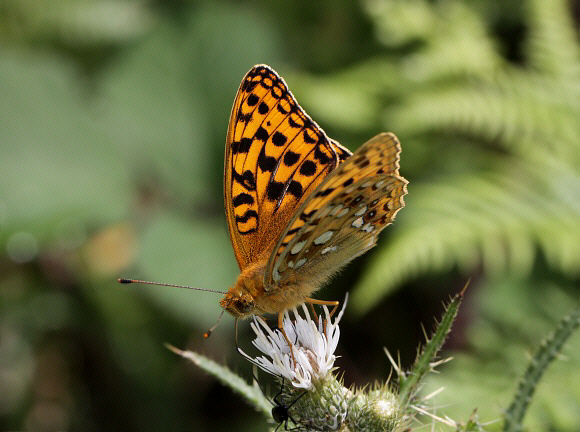 Argynnis adippe male, Arnside Knott, Cumbria – Adrian Hoskins
Argynnis adippe male, Arnside Knott, Cumbria – Adrian Hoskins
Adult behaviour
On cool or slightly overcast days the butterflies bask for long periods on the ground, choosing small depressions with dead vegetation, where they are sheltered from the wind. If disturbed they tend to only fly short distances and quickly settle in another nearby depression.
On warm sunny days males patrol rapidly across the habitat in search of females, pausing every now and then to nectar at thistle, bramble, heather, knapweed, burdock, hemp agrimony and other flowers. Females use the same nectar sources, but alternate between nectaring and ovipositing, typically dropping down to lay an egg at each of about half a dozen spots within a small area, and then spending 2 or 3 minutes nectaring at nearby flowers before repeating the process.
In late afternoon the butterflies tend to bask on bracken. Both sexes roost overnight in trees, on leaf clumps at the tips of the highest branches. They also fly up to settle in similar positions during overcast or wet weather.
